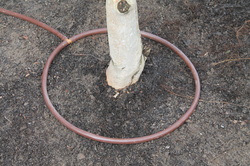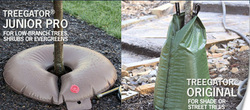Establishing New Trees and Plants
May 16, 2024
Let's examine using your irrigation or lawn sprinkler system to establish new plantings. We'll discuss drip irrigation, tree bags, scheduling strategies, and other techniques for ensuring that your new plantings survive!
Have you ever lost a newly planted tree or shrub? It gets expensive! One of the most common irrigation mistakes that we encounter in the field is providing water for new plants. We often see new plantings severely stressed, and usually the blame is placed on the irrigation system. Of course, planting anything during the months of peak temperature will be challenging, but a proper understanding of a plants water needs and your system's ability to provide those needs can translate into real money in your pocket!
I can't count the number of situations that I've seen where someone plants a row of 2" -3" (trunk diameter) trees, and expect their irrigation program of every other day or every third day to suffice. A new plant from the nursery will normally have instructions on how much to water. Sometimes that amount is given in a weekly number, but more often it's given in a daily amount. That daily amount is what's important to remember. In the winter or cooler months, when the ET or Evapotranspiration rate is 10 or 20% of it's summer peak, it may be possible to water every other day. Evapotranspiration is the amount of water lost from evaporation from the ground, combined with the amount of water that the plants transpire into the atmosphere. To give you some reference, I live in the Upstate of South Carolina. In January, our ET rate is .02 inches per day, but in July it's .2 inches per day. During the summer, a single mature tree can transpire 2-3 gallons of water a day.
A good, general estimate in the absence of a specific recommendation, is 10 gallons per week per inch of trunk diameter. Using this estimate a 2” trunk diameter tree would require 2.85 gallons a day. I performed a real world test on my own system to see how much water would be applied to an area equal to the rootball of a 2” tree, just like the Hollies pictured above. An average rotor run time for our area is about 30 – 40 minutes. So I ran the zone for 40 minutes and collected 2 Quarts or 1/2 of a Gallon. This zone has head to head coverage in a triangular pattern, with 3 heads covering this area. I generally run my system 3 days a week during the hot season. As we can see, this is completely inadequate.
Our primary concern is how much water that we can get to the rootball. A transplanted or container grown plant will have maybe 10 - 20% of the root area that it needs initially. Rootballs, especially those that have been burlapped can take up to two growing seasons to become completely established. The true challenge is keeping that plant alive during not only the first couple of months after the transplant, but also the crucial first summer in the ground. I've been told that a newly transplanted plant should be treated for the first year as if were still in a container. It should also be mentioned that we're talking about watering the rootball, not the hole prepared for the rootball. One should be preparing a hole twice as large as the rootball, but we must remember our focus.
Have you ever lost a newly planted tree or shrub? It gets expensive! One of the most common irrigation mistakes that we encounter in the field is providing water for new plants. We often see new plantings severely stressed, and usually the blame is placed on the irrigation system. Of course, planting anything during the months of peak temperature will be challenging, but a proper understanding of a plants water needs and your system's ability to provide those needs can translate into real money in your pocket!
I can't count the number of situations that I've seen where someone plants a row of 2" -3" (trunk diameter) trees, and expect their irrigation program of every other day or every third day to suffice. A new plant from the nursery will normally have instructions on how much to water. Sometimes that amount is given in a weekly number, but more often it's given in a daily amount. That daily amount is what's important to remember. In the winter or cooler months, when the ET or Evapotranspiration rate is 10 or 20% of it's summer peak, it may be possible to water every other day. Evapotranspiration is the amount of water lost from evaporation from the ground, combined with the amount of water that the plants transpire into the atmosphere. To give you some reference, I live in the Upstate of South Carolina. In January, our ET rate is .02 inches per day, but in July it's .2 inches per day. During the summer, a single mature tree can transpire 2-3 gallons of water a day.
A good, general estimate in the absence of a specific recommendation, is 10 gallons per week per inch of trunk diameter. Using this estimate a 2” trunk diameter tree would require 2.85 gallons a day. I performed a real world test on my own system to see how much water would be applied to an area equal to the rootball of a 2” tree, just like the Hollies pictured above. An average rotor run time for our area is about 30 – 40 minutes. So I ran the zone for 40 minutes and collected 2 Quarts or 1/2 of a Gallon. This zone has head to head coverage in a triangular pattern, with 3 heads covering this area. I generally run my system 3 days a week during the hot season. As we can see, this is completely inadequate.
Our primary concern is how much water that we can get to the rootball. A transplanted or container grown plant will have maybe 10 - 20% of the root area that it needs initially. Rootballs, especially those that have been burlapped can take up to two growing seasons to become completely established. The true challenge is keeping that plant alive during not only the first couple of months after the transplant, but also the crucial first summer in the ground. I've been told that a newly transplanted plant should be treated for the first year as if were still in a container. It should also be mentioned that we're talking about watering the rootball, not the hole prepared for the rootball. One should be preparing a hole twice as large as the rootball, but we must remember our focus.
A condition that we can see bearing upon transplanted plants is the compaction of the rootball and included soil. There is very little "pore space" in the average rootball due to the dense structure; many times plants are "rootbound" and need time to start spreading out the root network. To compound the problem, water typically won't flow from a saturated soil into the rootball. There are only minimal amounts of lateral water migration in most soils, so the primary concern is applying water directly to the rootball, and to further compound the problem, we can't apply too much water! Overly saturated roots during periods of elevated air temperatures can cause a plant much stress.
The proper solution to irrigating newly planted trees and shrubs must involve precise placement of water at very slow application rates to deeply penetrating depths. The best case solution is drip irrigation. Dripline can apply the needed amount of water at a very slow rate to allow proper infiltration into the rootball. Be careful, though, it's easy to overwater with drip if you don't understand the flow/application rate of the product that you're using. The supply house, contractor, or manufacturer can supply this info. Most of the manufacturers have friendly customer service lines.
The proper solution to irrigating newly planted trees and shrubs must involve precise placement of water at very slow application rates to deeply penetrating depths. The best case solution is drip irrigation. Dripline can apply the needed amount of water at a very slow rate to allow proper infiltration into the rootball. Be careful, though, it's easy to overwater with drip if you don't understand the flow/application rate of the product that you're using. The supply house, contractor, or manufacturer can supply this info. Most of the manufacturers have friendly customer service lines.
The next best solution is a tree bag. Treegator (unsolicited mention) is the brand that we're familiar with, they definitely perform as advertised. There are a couple different brands out there, but like anything else, find the product that you can rely on. These bags wrap around the base of a newly planted tree and soak water directly over the rootball at a slow application rate. One has to attach a garden hose about once a week or so to keep it filled. It's a little more visible, and requires a little bit of effort, but tree bags are a fine solution in the absence of an automated system.
So, what's the plan? Hopefully I've convinced you to take a more proactive role in caring for newly planted trees and shrubs. Consult with your landscaper or nursery to get localized suggestions for how much to water. Find a solution that allows you to water slowly every day, and pay attention to your plants!
So, what's the plan? Hopefully I've convinced you to take a more proactive role in caring for newly planted trees and shrubs. Consult with your landscaper or nursery to get localized suggestions for how much to water. Find a solution that allows you to water slowly every day, and pay attention to your plants!
Begin or advance your career in irrigation / sprinkler systems with specialized courses or our Certification Program.
Stay connected with news and updates!
Join our mailing list to receive the latest news and updates from our team.
Don't worry, your information will not be shared.
We hate SPAM. We will never sell your information, for any reason.




